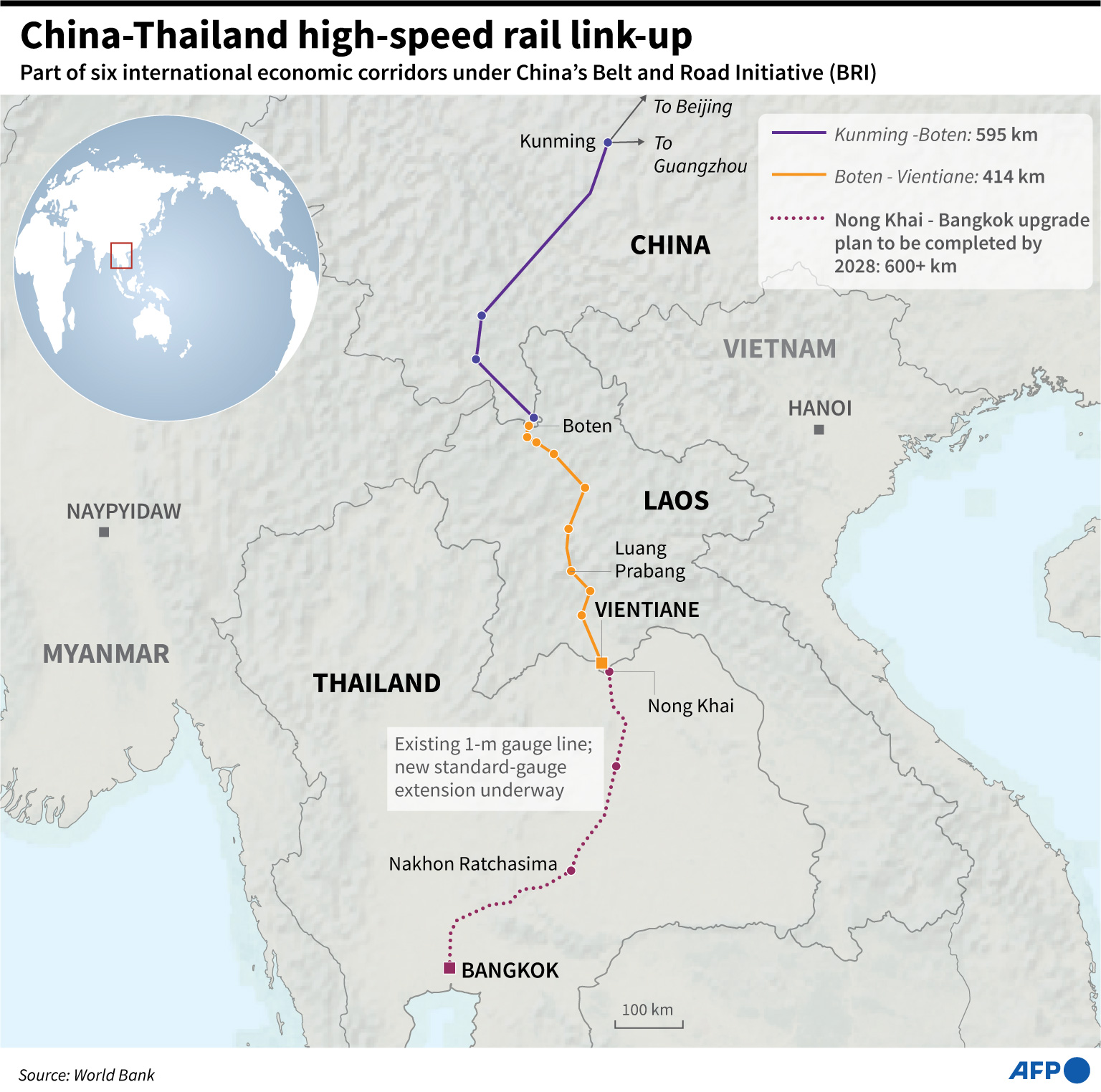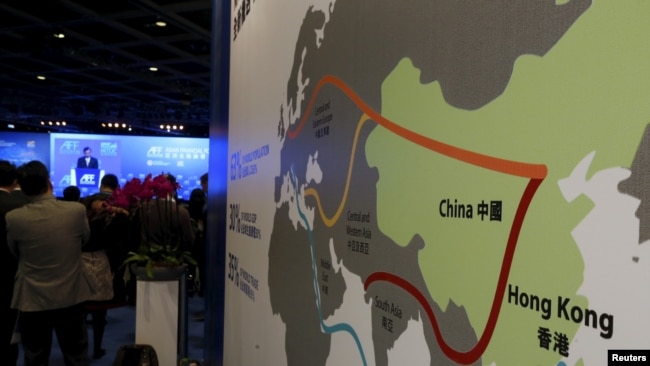Thailand Sets 2028 Target to Finish High-Speed Rail Link with China

Thailand’s recent pledge to finish a long-delayed high-speed rail line linking it to China through Laos within six years is reigniting doubts about the country’s commitment and whether the $12 billion megaproject will pay off.
Transport and Foreign Affairs ministries officials told reporters July 6 Thailand will complete the 609-kilometer line from the capital, Bangkok, to the Lao border at Nong Khai, now only 5% built, by 2028. Nong Khai is just across the Mekong River from the Lao capital of Vientiane, where a high-speed train to the Lao-China border started service in December.
With trains running at a maximum speed of 250 km/h, the new line will collapse the time the Bangkok-Nong Khai journey takes now on existing standard-gauge tracks.
The 2028 announcement came a day after Chinese Foreign Minister Wang Yi met with Thai Prime Minister Prayut Chan-ocha and Foreign Affairs Minister Don Pramudwinai in Bangkok. A Thai Foreign Affairs Ministry statement on Wang’s visit says the meeting included talks on a “Thailand-Laos-China Connectivity Development Corridor.”
The project is part of Beijing’s long-term plans to link China’s Yunnan province to the bustling ports of Singapore via high-speed trains cutting through Laos, Thailand and Malaysia in a key piece of its grand Belt and Road initiative.
Cautious commitment
When Thailand started planning its portion of the line with China over a decade ago, the goal was to have it done by about the same time as Laos finished its own 414-kilometer stretch, Ruth Banomyong, a professor of international trade, transport and logistics at Thailand’s Thammasat University, told VOA. But with that target long since abandoned, he said top government transport officials were still noncommittal on a new goal just last month at a seminar he attended, making the announcement on July 6 “a bit confusing.”
Ruth said the new target was feasible but may be more of a political statement than a “technical” one, made with an eye on national elections due next year and Prayut’s fractious coalition government looking increasingly unsteady.
“The prime minister is probably at his lowest in terms of various [opinion] polls that have been published, and he wants to stay in power, but he needs to have something to show for himself,” said Ruth. “So, they need to re-put this project in the public eye, saying that, oh yes, it is going to be done.”
He said growing frustration in Beijing with the pace of Thailand’s progress may have played a part in the announcement, too.
“The fact that it’s announced after a meeting with the Chinese foreign minister, Wang Yi, it does make it look like they’re feeling some pressure to be at least looking like they’re moving forward with this project,” said Greg Raymond, a lecturer at Australian National University studying China’s growing connections with mainland Southeast Asia.
“But when you look at the pattern of [Thailand’s] decision-making, the pattern of action … the degree of commitment has to be questioned,” he added.
Analysts say the line, once complete, will help plug some of Southeast Asia’s largest and most dynamic economies into China’s landlocked south, giving the underdeveloped region a much-needed boost.
As with much of the Belt and Road Initiative, Raymond said, it also builds on Beijing’s broader goal of forging a regional economy centered on China, and of wielding that position to bend the foreign policies of other countries to its will. At the same time, he added, linking southern China to some of mainland Southeast Asia’s main ports would ease the pressure on China’s vital sea trade routes in case of conflict.
“If there’s a conflict between China and the United States, I think one of the things that China’s vulnerable to is a blockade by the [U.S. Navy’s] 7th Fleet, particularly at the Malacca Strait, so I think there is that sort of strategic imperative,” Raymond said.
Cost and benefit
For Thailand, the new line could mean more exports to, and investment from, China.
Ruth, though, said it will take decades, not years, for the $12 billion project to pay for itself, and only if the government also invests in the additional freight and passenger services needed to bring out the line’s full potential. Done right, he added, the line could also spur new growth and development along its route through Thailand’s rural northeast.
But Ruth said the government has yet to share its forecasts for key factors such as passenger numbers or freight traffic, making a hard-nosed assessment of the project impossible.
“What we tend to see is that a lot of these forecasts are very, very optimistic, and that’s why you sometimes end up with having white elephants … nice infrastructure that is not utilized fully, so that’s really the risk,” he warned.
Bryan Tse, Southeast Asia analyst for the Economist Intelligence Unit, said the high-speed train line’s focus, for now, appears to be on passengers, not freight, dimming the odds that Thailand can make the $12 billion back in 10 or even 20 years. If the main goal were boosting freight traffic, he said China would probably have focused on upgrading the network of regular train tracks crisscrossing Southeast Asia already, which would be cheaper.
But the project need not necessarily pay for itself directly to pay off for Thailand in other ways, Tse added.
“If getting this railway done means that you get the good will of the Chinese government … then you may get a lot of things in return politically and economically, in terms of investment, for instance,” he said.
Still, the analysts say Thailand is likely to remain hesitant about the project; $12 billion is a lot, and the added strain the pandemic has put on the country’s economy will only make it harder to move forward on the line to Laos, not to mention any high-speed line that might eventually be built south of Bangkok to Malaysia.
Raymond said Thailand is also wary of any moves, the high-speed rail line included, that might draw China too close for comfort.
“They don’t want to be drawn in, really, to a Beijing-centered economy if they think it’s going to reduce their freedom of maneuver,” he said. “They’re always seeking to balance their relationships; they don’t want to become too dependent on any of them. This is the classic hedging behavior, but it’s very strong with Thailand.”
Now that Laos is done with its stretch of the line, the analysts agreed that China is likely to focus its attention on seeing that Thailand picks up the pace.
Whatever their reservations, Raymond said, their Thai partners “might eventually feel like they have to do it.”




